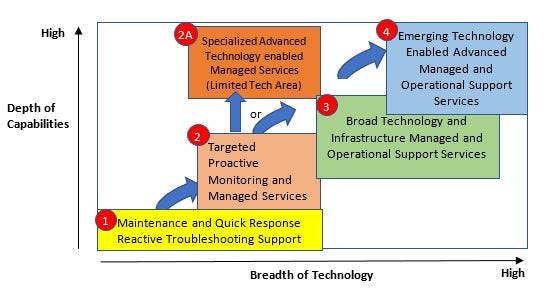3 Steps to Managed Services Selling
Selling managed services isn't an easy pivot for VARs and agents, but doable with self-awareness and analysis.
September 11, 2017


Michael Smith

Kevin Mulloy
By Michael Smith, Senior Managing Director, and Kevin Mulloy, Principal, Blue Ridge Partners
For channel partners, cloud is a mixed blessing. On one hand, customers are becoming less captive, putting pressure on revenues and margins. At the same time, the market is moving from products to solutions, meaning partners have an opportunity to re-invent their businesses and provide profitable “Day 2” managed services and support. But getting there isn’t easy. To retain traction with customers and continue to offer value to vendors, today’s VARs are grappling with three pivotal questions:
What does the evolving managed services landscape look like now?
How do I decide where to focus to grow my managed services revenue?
How do I execute the move to selling managed services?
 The importance of proactively addressing these questions cannot be understated. At the same time, though, understanding the perspectives and strategy of your vendors is critical for channel partners to remain relevant in a changing channel mix.
The importance of proactively addressing these questions cannot be understated. At the same time, though, understanding the perspectives and strategy of your vendors is critical for channel partners to remain relevant in a changing channel mix.
What Does the evolving managed services landscape look like? Becoming a player in today’s managed services landscape starts with a detailed understanding of what that landscape looks like. There are four main managed services spaces in which companies can play today:
Maintenance and reactive troubleshooting: This basic support level provides a “dial for help” lifeline for customers to get basic advice and troubleshooting support from a known and knowledgeable resource.
Proactive monitoring and managed services: This Level 2 support leverages proactive, 24/7 monitoring and management. This support comes from an operational NOC which is constantly monitoring clients’ infrastructures to identify and resolve problems before they cause additional issues or outages. This can be specialized in a Level 2A support, which stays within a limited technology area.
Technology and infrastructure support services: Level 3 provides …
… Level 2-type services but across a broad array of technology areas, allowing clients to leverage a single provider to simplify operations and engagement while receiving a full range of infrastructure and application monitoring and support services in a hosted or XaaS mode.
Technology-enabled advanced managed services: Level 4 adds analysis and support capabilities by leveraging new emerging technologies in APM, data analytics, IoT, DevOps and advanced security, providing deep analysis and development capabilities to anticipate and better respond to critical situations.
How do I determine where to focus? While the evolutionary path looks clean and logical on paper, it can be overwhelming to consider moving down the managed-services path. Where should you start, given limited resources? There are four elements to consider when determining the best direction for your company:
Who are my current customers? Evaluate your current base to see where you have strong relationships. Segment customers, and develop slates of managed services that meet particular needs. Consider investment/ROI, and ask yourself: “What are all the services my customers want today and tomorrow?” Make a list. Some of the items on that list may be far afield from your current offerings, while some may be close to the core. Your direction must be practical, it must logical and it must consider where customers will give you permission to play.
What managed service areas are adjacent to my core? If a new managed-services space is too far afield from your core capabilities, current customers usually won’t move along into the new space. That’s why it makes sense to focus initially on areas adjacent to the core. This expansion of capabilities can happen through acquisition, through adding on skills or other steps that enable a logical, step-wise progression of capability. Typically, in building out your core capability, close linkage and active dialogue between the professional services team and the nucleus of your managed services team will be important.
What existing capability can I build on? For example, you may have a group that’s very good at providing basic reactive customer support and has naturally started to extend their knowledge into proactive customer support. Build on and formalize that capability.
What does the business case look like? You know your likely customers, you’ve looked at the managed services areas that are close to your core, and you’ve got a group you can build around. Now the question is, can the current sales team sell these services? What’s the business model? New services require investment — investment in people, in tools, in capabilities and more. Putting together a business plan for the most promising areas can clarify which is the right direction for your company. Typically, the areas with the potential to deliver the highest ROI are the most promising, though also look at future potential upside.
How do I execute the move to managed services? Once you decide where to focus, the next step is to create a road map that will get you from where you are today to where you want to be on the managed-services spectrum. Be very clear on the specific steps that must be launched sequentially to get from point A to point B. This isn’t just about service evolution; it also involves an evolution of skill sets, technology, people, process (how do I organize around this?) and, importantly, …
… leadership and culture. Firms must have the right leadership in place to guide the transition to managed services in a coordinated, well-considered way. One of leadership’s most important roles is to create a new culture of service and embed a “Day 2 Support” mindset into the fabric of the company.
As part of the evolution of skill sets, the importance of the sales team cannot be underestimated. Typically, sales reps who are currently selling “boxes” or maintenance and reactive troubleshooting-type services find selling managed services very difficult. It’s not simply a matter of selling a different product; it’s a different type of sale to a different type of buyer and requires a far different skill set.
There are typically seven aspects to helping channel partners re-tool in this new world:
Build an external view of the market. Thoroughly understand end-customer values, what they want and need, and how they make purchasing decisions.
Prioritize end-customer segments. Segment end-markets and identify high-value segments. We look at pace of adoption and receptiveness to SaaS/XaaS. This results in a clear view of revenue opportunity and urgency to reach.
Identify your solution set. Pinpoint the optimal set of managed services – proactive UC monitoring, XaaS, BC/DR support services – that best fit new end-customer values.
Understand capability gaps. Know what is required to sell and market the suite of solutions. Do gap analysis of capabilities to deliver vs. what is in place. Identify missing capabilities and implement them.
Integrate any current managed services. Bring your offerings all together under one strong leader who can drive expansion.
Revamp the sales model. Adapt to the changed perspective of customers, the different decision-making dynamics and the more managed services-type of offerings.
Develop GTM strategy. Target high-value customer segments, delivering the optimal set of solutions in collaboration with vendors. We take an active role in the implementation to ensure results.
The challenges faced by channel partners today may be opportunities in disguise. To be sure, the evolving managed-services landscape has some landmines to avoid, but as is often the case, the key to success lies in adapting to new models instead of resisting them and a firm understanding of what customers want today instead of last year — and then understanding how to give it to them.
Michael Smith is senior managing director at Blue Ridge Partners. He has significant experience working with key players in the technology value chain, and helps VARs understand the implications of a changing world and drive profitable revenue growth in light of vendor priorities and concerns.
Kevin Mulloy is a principal at Blue Ridge Partners. His 30+ year career has focused on innovation and technology management issues for a wide range of high-tech and industrial clients. Throughout his career, he has led Managed Services and corporate development projects, and has been responsible for several strategic OEM and channel partner initiatives.
Read more about:
AgentsYou May Also Like
